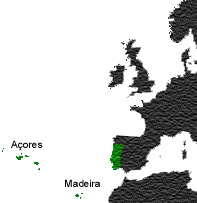


 Official
Name: Republic of Portugal
Official
Name: Republic of Portugal
Area: 91,905 square kilometers including Madeira and the Azores.
Location: Portugal is the westernmost country in Continental Europe. It is bounded by Spain on the north and east and by the Atlantic Ocean on the south and west.
Highest Elevation:
Serra da Estrela 1,993 km (Continent), Pico 2,351 km (Azores)
Time Zone: GMT; EST+5 hours
Population: Approximately 10 million in 1996, of which 9.4 million live in Continental Portugal, 257,000 in Madeira and 241,000 in the Azores.
Religion: Roman Catholic (97%), Protestant (2%) and other (1%)
Major Cities:
Lisbon has been
the capital of Portugal ever since the Moors were conquered in 1147. It
is a legendary city with over 20 centuries of history. Boasting balmy winters
and cool summers freshened by soft Atlantic breezes, the Lisbon area offers
some of Europe's finest hotels for both business and pleasure. The city
itself, situated on seven hills like Rome, combines the historical with
the modern. The sidewalks, paved with hand-hewn cobblestones forming myriad
designs, are unique in Europe. Many buildings, old and new, are covered
by characteristic blue tiles called azulejos. A growing city, Lisbon's
expanding periphery is marked by modern high-rises and some of Europe's
largest shopping centers.
In Lisbon's narrow streets of the old quarters-the Alfama and the Bairro Alto-visitors can hear the typical Fado music being played and sung in numerous small restaurants. Colorful festivities are held during the year such as the feast day of St. Anthony - Lisbon's patron saint - in June, and Independence Day in December. There are more than 35 museums, a modern convention center and unique and impressive monuments such as that of the Portuguese Navigators and Discoverers overlooking the gateway to the Atlantic. Indeed, Portugal's maritime history will be celebrated in a special way at Lisbon's Expo '98, the last world's fair of the century, that will run from May 22 to September 21, 1998. Its oceanic theme commemorates the 500th anniversary of Vasco da Gama's voyages to Asia.
Oporto - Situated at the mouth of the Douro River in the northern part of the country, Oporto is Portugal's second largest city and a major harbor. The city lends its name to the renowned wine. And Port wine has been a major export from that area for centuries. Oporto combines an old city center overlooking the Douro with such modern arrivals as Portugal's busy and successful Futures and Options Market (FUTOP) that started operating in 1996.
Braga - Founded by the Celts in 300 BC the city became an important administrative center in Roman times. Today it is a major religious center and site of the oldest cathedral in Portugal. It is also the center of the important clothing and textile industry which are among Portugal's principal exports.
Coimbra - One of Europe's oldest university towns, it has kept ancient academic traditions such as seen in black-caped students, the soulful tones of the Fado and the burning of ribbons. Its famous tower dominates the city skyline and the university's sumptuous Baroque library holds a precious collection of ancient books and manuscripts.
Faro - Capital of the southernmost Algarve region, an area famed for its fine beach resorts, Faro's airport is Portugal's third busiest. The city has a medieval wall, a number of monuments and museums and is the gateway to many small towns and villages characterized by houses with whitewashed walls and colorful chimneys, sturdy granite palaces and Roman ruins.
Funchal - Capital of the island of Madeira, its name is derived from the intense, licorice-sweet scent of the wild herb fennel, funcho in Portuguese. A long-established resort, Funchal offers many fine hotels and sports and entertainment facilities. It has a vast and colorful flower market, is world famous for its fine embroideries and for its sweet wine, also named Madeira.
Language: The language of Portugal is Portuguese, one of the five major romance languages derived from Latin. English is widely spoken by the business community.
Currency:
Gross Domestic Product (GDP):
|
|
|
|
|
+5.0% in 1986-90
+2.8% in 1991-95 +3.2% in 1996 +3.5% in 1997 (est) 3.8% in 1998 (forecast) |
|
(Gross Added Value) |
Agriculture, Forestry and Fishing 4%
Industry, Construction and Energy 33% Services 63% |
|
|
$10,720 |
Major Harbors:
Natural Resources: Fish, cork, tungsten, zinc, copper, and marble; small deposits of uranium, iron and manganese.
Major Industries: Textiles, apparel, footwear, automotive, woodpulp, paper, cork products, wine, ceramics, chemicals.
Major Holidays (Continental Portugal):
|
|